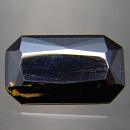|
|
||||||||||||||||
|
||||||||||||||||
|
||||||
|
|
|
|
Euxenite-(Y)
|
|
| | |
| Discovered in 1870; IMA status: Valid (pre-IMA; Grandfathered) | ||
|
| ||
|
Chemistry |
|
|
| |
|
(Y,Ca,Ce,U,Th)(Nb,Ta,Ti)2O6 | |
|
|
Yttrium Calcium Cerium Niobium Tantalum Titanium Oxide |
|
Molecular Weight: |
392.28 gm |
|
Composition: |
Calcium |
2.04 % |
Ca |
2.86 % |
CaO |
|
|
Cerium |
3.57 % |
Ce |
4.18 % |
Ce2O3 |
|
|
Yttrium |
15.86 % |
Y |
20.15 % |
Y2O3 |
|
|
Tantalum |
18.45 % |
Ta |
22.53 % |
Ta2O5 |
|
|
Titanium |
2.44 % |
Ti |
4.07 % |
TiO2 |
|
|
Niobium |
33.16 % |
Nb |
47.43 % |
Nb2O5 |
|
|
Oxygen |
24.47 % |
O |
|
|
|
|
|
100.00 % |
|
100.00 % |
= TOTAL OXIDE |
|
|
|
||||
|
Classification |
|
|
| |
|
Oxides | |
|
4/D.14-20 | |
|
|
4 : OXIDES (Hydroxides, V[5,6] vanadates, arsenites, antimonites, bismuthites, sulfites, selenites, tellurites, iodates)
|
|
Related to: |
Polycrase Group |
|
Varieties: |
None |
|
Synonyms: |
Euxenite, Guimaraesite (of Gagarin & Cuomo), Lyndochite |
|
|
|
|
Crystal Data |
|
|
|
|
|
Orthorhombic - Dipyramidal (may be metamict - a mineral originally crystalline, eventually amorphous due to radiation damage) |
|
|
As stout prismatic crystals, to 10 cm, may be flattened || [100] or [010]; commonly in parallel, subparallel, or radiating aggregates; compact massive. |
|
|
Common on {201}; rare on {101} or {013} |
|
|
|
|
|
Physical Properties |
|
|
|
|
|
None |
|
|
Conchoidal to Sub-Conchoidal |
|
|
Brittle |
|
|
5.5 - 6.5 |
|
|
5.30 - 5.90 (g/cm3) |
|
|
None |
|
|
Mild; GRapi = 3,420.62 (Gamma Ray American Petroleum Institute Units) |
|
|
|
|
|
Optical Properties |
|
|
|
|
|
Black, Brownish Black, Greenish Black; Brown to Yellow-Brown in transmitted light |
|
|
Opaque, Translucent on thin edges |
|
|
Vitreous to Sub-Metallic, Waxy to Resinous on fractures |
|
|
2.06 - 2.24 Isotropic; R1–R2: (470) 13.7–15.6, (546) 13.0–15.6, (589) 12.5–15.0, (650) 12.4–15.0 |
|
|
0.000 Isotropic |
|
|
None |
|
|
|
|
|
Occurances |
|
|
|
|
|
Geological Setting: |
From granite pegmatites; as a component of detrital black sands |
|
Common Associations: |
Aeschynite-(Y), Albite, Allanite, Betafite, Beryl, Biotite, Columbite, Gadolinite, Garnet, Ilmenite, Magnetite, Microcline, Monazite, Muscovite, Thorite, Uraninite, Xenotime, Zircon |
|
Type Locality: |
Jølster, Sunnfjord, Sogn og Fjordane, Norway |
|
Year Discovered: |
1870 |
|
View mineral photos: | |
|
|
|
|
More Information |
|
|
|
|
|
| |
|
|
|
|
Euxenite-(Y) is a very rare radioactive mineral that belongs to the Polycrase Group of minerals that includes Euxenite-(Y), Polycrase-(Y) and Yttrocrasite-(Y). Because of the rare earth metals in its structure, Euxenite is one of several minerals called "Rare Earth Oxides". Other rare earth oxides such as Aeschynite, Fergusonite and Samarskite have very similar properties to Euxenite and are often associated with each other. Faceted Euxenite gems are extremely rare and really only faceted as a collector's oddity. Euxenite is a mildly radioactive mineral and should be stored away from other gems and minerals that are subject to damage from radioactivity and of course human exposure should be limited. Euxenite may be metamict due to its mild radioactivity. Metamictization is a natural, gradual process of the complete destruction of the internal crystal structure of a mineral due to radiation present in the mineral or from nearby external radiation. Metamictization eventually leaves the mineral amorphous or without any internal crystal structure. Once this process is complete the mineral is desctibed as metamict. There are numerous Euxenite localities worldwide. In Norway, from Jölster, Söndfjord; at Alve, on Tromö Island; on Hidra (Hitterö) Island, near Flekkefjord; at many other places between Tvedestrand and Arendal, and in Iveland and Evje Parishes, Sätersdal. In Sweden, in the Ruoutevare Fe–Ti deposit, near Kvikkjokk, Norrbotten; at Ytterby, on Resarö Island, near Vaxholm; and elsewhere. From Huntila, Pitkäranta district, Lake Ladoga, Karelia, Russia. In Madagascar, large crystals from Vohimasina; Ambatofotsikely; Ankazobe, near Ambohitantely; Ambolotara; Ranomafana; and elsewhere. In Brazil, from Santa Clara, Pomba, and Espirito Santo, Minas Gerais. In Canada, from Lyndoch, Sabine, and Mattawan Townships, and elsewhere in Ontario; also in Quebec. In the USA, from the Rutherford pegmatite, Amelia County, the Nanco pegmatite, Bedford County, and others in Virginia; from Morton, Delaware County, Pennsylvania; at Encampment, Carbon County, Wyoming; from Guffey, Park County, near Bergen Park, Jefferson County, and the Colorado feldspar pegmatite, Fremont County, Colorado. |
|
|
Euxenite gems for sale: We have not photographed our Euxenite gems. Please check back soon. |
